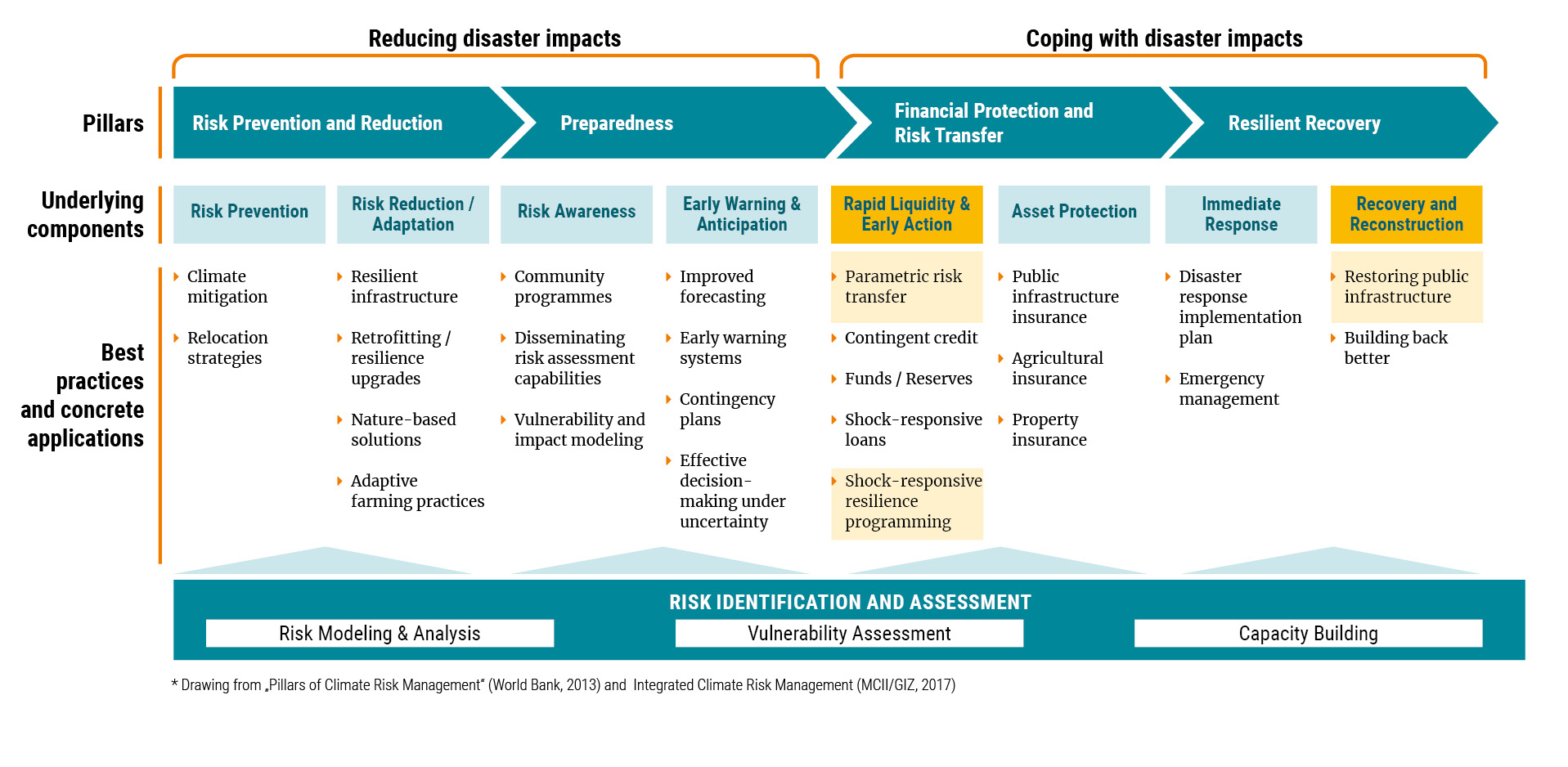Workstream 2: Action & Implementation
Enable effective action and implementation of high-quality Climate and Disaster Risk Finance and Insurance solutions in poor and vulnerable countries
Global Parametrics - Mexican Reef Protection Program Blending Parametric Insurance and Nature-based Solutions
By Global Parametrics
Global Parametrics led the renewal of the landmark Mexican Reef Protection Program alongside Grupo Finaciero Banorte and Hannover Re. It structured a parametric solution which pays out to support the rapid restoration of a key section of the Mesoamerican Reef following a tropical cyclone event. Hannover Re acted as the reinsurer for the solution and shares the risk with the Global Parametrics Natural Disaster Fund (NDF).
The Mexican Reef Protection Program was established in 2018 by a number of private, public and international stakeholders and it is the world’s first nature-based solution to incorporate parametric insurance for a coral reef. The Program enhances and protects an environmental asset by providing the funds for rapid restoration post-disaster, while also mitigating the impact to the local economy in the state of Quintana Roo on the Yucatán Peninsula in Mexico.
Country Background
The Mesoamerican Reef is the longest barrier reef in the Western Hemisphere and it forms the habitat for some of the world’s most important aquatic biodiversity. The Reef and beaches are key assets for local tourism. Every year, more than 12 million tourists come to Quintana Roo, generating revenues of USD 9 billion and providing an estimated 148,300 jobs¹. Studies by the World Travel and Tourism Centre (WTTC) highlighted that 49.6% of the local GDP of Quintana Roo in 2017 was dependent on tourism activities and 37.7% of the working population were employed in the tourism sector².
The Reef also creates disaster risk-reduction capabilities for the area against tropical cyclones. Recent studies have highlighted that the Reef provides protection of USD 42 million in the form of damage prevention for buildings and USD 20.8 million for hotel infrastructure in Quintana Roo³.
¹ Travel2Latam, 2018. ‘Cancún, World Leader in GDP Generation and Tourism Employment’.
² World Travel and Tourism Council, 2017. ‘Travel and Tourism: Global Economic Impact & Issues 2017’.
³ Borja et al, 2019. ‘The Risk Reduction Benefits of the Mesoamerican Reef in Mexico’.
However, reefs themselves are vulnerable to cyclone risk and may lose between 20–60% of live coral cover after a category 4 storm. Loss of reef height amounting to just one metre can double the cost of damage and loss to such coastal communities when a storm occurs in the future.
Rapid reef restoration in the wake of a tropical cyclone has been proven to increase disaster risk reduction to communities and erosion on surrounding beaches. Reducing and repairing damage to reefs and beaches maintains or increases the Reef’s capacity to reduce wave energy by up to 97% and consequently reduces onshore damage and coastal erosion. This also benefits local economies in the aftermath of future events and reduces overall losses.
¹ Travel2Latam, 2018. ‘Cancún, World Leader in GDP Generation and Tourism Employment’.
² World Travel and Tourism Council, 2017. ‘Travel and Tourism: Global Economic Impact & Issues 2017’.
³ Borja et al, 2019. ‘The Risk Reduction Benefits of the Mesoamerican Reef in Mexico’.
Project description
In 2018, The Nature Conservancy along with the local government of Quintana Roo and various stakeholders from the tourism and hospitality sector developed a Coastal Zone Management Trust to cover a portion of the Mesoamerican Reef against tropical cyclone risk. In partnership with Swiss Re and the Rockefeller Foundation, the Mexican Reef Protection Program was formed on the basis of a parametric insurance policy which pays out to support the rapid restoration of the protected area following a specified tropical cyclone event. A portion of the premiums were covered through local taxes from the hospitality sector which the Reef itself shields.
Global Parametrics led the 2020 renewal by structuring a parametric solution to pay out in the event of a pre-identified wind speed (100 knots) within 60 kilometres of a specified geography for the Mesoamerican Reef. If wind speeds are in excess of 100 knots, an insurance payout will be made rapidly to the trust fund, allowing swift damage assessments, debris removal and initial repairs to be carried out. Longer periods of restoration and recovery work may follow in order to restore the Reef’s value as a coastal barrier.
Alongside the insurance mechanism, the Program also has an educational element. It establishes training response teams named Guardians of the Reef with the knowledge and capacity to rehabilitate impacted coral reefs in the protected areas following a tropical storm event. 60 Guardians of the Reef had been trained by 2020.
The Program is structured on the basis of a local risk transfer agreement between Grupo Finaciero Banorte and the Coastal Zone Management Trust. Banorte is reinsured by Hannover Re and the Natural Disaster Fund (NDF) operated by Global Parametrics provides further capital.
This Program was successfully utilized in October 2020 when Hurricane Delta devastated the Yucatán Peninsula. Desperately needed funds were paid out to the Coastal Zones Management Trust.

The impacts on the local tourism industry from Covid-19 have been devastating. Ensuring safe beaches and protected coral reefs lowers the costs of repairs for infrastructure and asset loss to the local government post-tropical storm, safeguarding budgets which are already constrained as a result of the response to the pandemic.
Carlos Joaquin, Quintana Roo’s State Governor

Covid-19 impact and response
While Covid-19 and its related response have limited implications for the direct protection provided to the Reef and the associated restoration activities, unfortunately Covid-19 repercussions have seriously affected Mexico’s tourism industry. Revenues were just 6.3% of the usual year-earlier amount generated for April. Mexico registered only 86,000 foreign visitors in April, down from 2.8 million during the same month in 2019. The impact of Covid-19 in Quintana Roo has been large owing to falling visitor numbers and tourism revenue. This has impacted the funds received from the local government to maintain the Program, compounded by increasing prices from the traditional insurance market.
The compound risk to communities in Quintana Roo was high for 2020, given the heightened risk of tropical cyclones in the region (evidenced by the payout in October) and the loss of revenue due to low visitor numbers. As a result, Global Parametrics and the Natural Disaster Fund decided to continue the Program in order to ensure the success of such a pivotal environmental and social initiative. It is particularly relevant given the Program’s flagship status and in the current Climate Emergency. The continued success of the Program demonstrates that this is a model which can be mapped onto other natural assets.
Global Parametrics & InsuResilience Investment Fund
Global Parametrics (GP) was launched with funding from the British Government and the InsuResilience Investment Fund (IIF). Its mandate is to strengthen resilience to extreme weather and natural disasters in low and middle-income countries. GP works with the public, private and non-profit sector, using its innovative climatic, seismic and financial risk modelling to rethink resilience for a new era of risk.
GP products are backed by the Natural Disaster Fund (a blend of private and public capital). Similar to an insurer, the Natural Disaster Fund collects fees and makes payouts on parametric derivative contracts when extreme weather or natural disasters occur.
The InsuResilience Investment Fund (IIF) is an initiative created by KfW, the German Development Bank, on behalf of the German Government. The overall objective of the fund is to promote adaptation to climate change by improving access to and use of insurance in developing countries. The specific objective of the fund is to reduce the vulnerability of micro, small and medium enterprises (MSMEs) along with low-income households to extreme weather events.
Summary Table
Overview | |
|---|---|
Risk(s) to be covered | Tropical cyclone |
Product/Solution | The Mexico Reef Protection Program – nature-based solution to protect the Mesoamerican Reef |
Objective | Providing parametric insurance protection for the rapid restoration of 60 kilometres of the Mesoamerican Reef located along the Yucatán Peninsula, Mexico, after a tropical cyclone. The Reef itself has inherent disaster risk-reduction capabilities, protecting local beaches, infrastructure and ensuring business continuity for tourism-dependent enterprises in the local economy. |
Beneficiaries | Communities and those involved in the tourism industry in the Yucatán Peninsula. 4,6004 (direct); 417,979 5 (indirect) |
InsuResilience Global Partnership Members and their partner organizations/governments | The Natural Disaster Fund, Global Parametrics, Hannover Re, Groupo Finaciero Banorte |
Climate and Disaster Risk Management
Placement of this project along the climate and disaster risk continuum:

